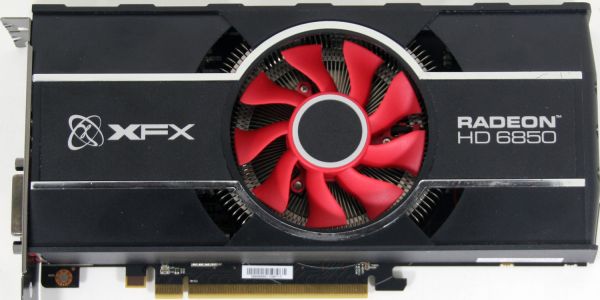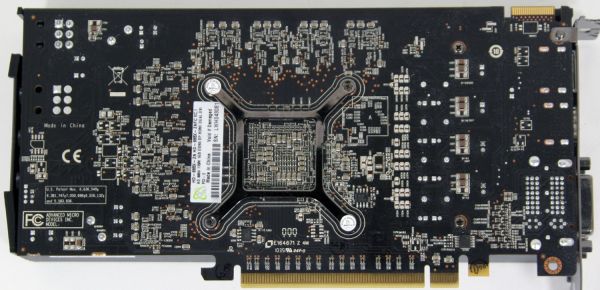AMD Radeon HD 6850 Overclocking Roundup: Asus, XFX, & MSI
by Ryan Smith on November 8, 2010 12:40 AM ESTMeet The XFX Radeon HD 6850
Kicking of our look at 6850s is XFX’s Radeon HD 6850 (HD-685X-ZNFC), a card we’ve had since the 6850 launch two weeks ago and provided to us by XFX to allow us to test 6850 CrossFire performance.
In terms of design the XFX 6850 only bears little resemblance to the reference 6850. The PCB runs half an inch shorter than the reference 6850, measuring 8.5”, while among other differences the XFX 6850 has a second unused set of pads for a second 6pin PCIe power socket. Unfortunately the PCIe power socket is still rear facing, meaning while the card is shorter than the reference 6850, you need to factor in space needed for a PCIe power cable. Meanwhile in terms of build quality the card is fairly normal for a mainstream video card; along with the usual solid capacitors, XFX is also using solid state ferrite core chokes here.
Attached to the top of the card is a completely custom cooler. As is common with cards in this price range and performance level, XFX has ditched the 5850/6850 blower for a more open design that features a center-mounted fan that blows air out the front and the rear of the card. These open designs are both cooler and quieter as air doesn’t need to be forced through several inches of heatsink & shrouding, at a cost of relying more on a case’s cooling abilities. XFX is using a partially shrouded design in order to keep hot air from blowing out of the bottom of the card & towards the motherboard, along with providing some structural stability to the card.
Interestingly, XFX is using a vapor chamber cooler here, which is uncommon for cards at this price range. As you may recall, vapor chambers are effectively flattened heatpipes that sit between a GPU and heatsink, and offer better cooling than a simple solid-metal heatsink base. We’ve never been able to get a solid idea on pricing, but it’s our belief that vapor chamber coolers end up costing more to build than similar heatpipe coolers, which makes the inclusion of a vapor chamber on a sub-$200 card an unusual choice. In any case, the vapor chamber is then attached to a fairly typical circular aluminum heatsink, with fins running up to the top of the card and the fan embedded in the middle. As we’ll see in our test results, the cooling design on the XFX 6850 keeps the card exceptionally cool, but XFX has turned the card for cooling performance at the cost of noise.

Cross-Sectional Diagram Of XFX's Cooler
For the port configuration, XFX has deviated from AMD’s new Eyefinity port configuration in place of the older 5800-series port configuration. This means along with the two DVI ports and the HDMI port there’s only one full-size DisplayPort, versus the two mini-DP ports that AMD has been pushing for these cards. This is a DP 1.2 port, so the XFX 6850 can still drive up to 3 monitors from it, but the card will be unable to drive 6 monitors (instead being limited to 5) as it lacks the necessary outputs.

As far as packed-in items are concerned, as the 6850 is a mainstream card you won’t find any significant included with the card. XFX includes the usual collection of a quick start guide, warranty guide, and driver CD along with a XFX-banded doorknob hanger. However you won’t find any dongles, cables, or power adapters here – in fact XFX doesn’t even officially support using a 2x Molex to 6pin PCIe power adapter.
Finally, XFX is providing their standard double lifetime warranty for the card; 2 years if unregistered with the double lifetime warranty taking effect if the card is registered. Not surprisingly this along with XFX’s design choices have pushed the price of the card up a bit, with the XFX 6850 available for around $190, $10 over the AMD baseline MSRP.


















93 Comments
View All Comments
Mr Perfect - Monday, November 8, 2010 - link
AT normally tears the cooler off to examine the card, and then dissects the cooler itself too. Neither 6800 article has done this though. It should be an even bigger priority when we're comparing non reference cards that are competing purely on their unique designs. Are these cards on loan? Do they have to be returned in the same condition they where received? If so, I say just ship them back without reviewing them. :PI just came from XBitLabs, where they did a proper teardown of both a stock 6850 and 6870, and that Asus card looks a lot like the stock 6870 board. It has the two top mounted PCIe power connectors, and the VRMs appear to be between the GPU and IO ports. I would not be surprised if it really was a 6870 PCB. Check it out!
khimera2000 - Monday, November 8, 2010 - link
I appreciate the review, it looks alot less of a hot article as the last one, and its clear that a good amount of effert went into this article just by the comments AT left, and the way the article was written.I was also wondering when will the review of the higher end 6xxx card be availabe?
Cali3350 - Monday, November 8, 2010 - link
A lot of Doom and Gloom here about the OC cards. Let me try and tell you, Ryan and Anand, what I think the people want as a majority:1. Never use OC'd cards in a initial review. Ever. You guys, quite frankly, should have known this and the flak you are getting for using it is deserved imo. Nvidia conned you guys into making their cards unfairly better than the competition in the main review article of a major launch and you fell for it. That article will likely get much more readership than any roundup, and is likely to be looked up in higher numbers down the line. You played that one like a PR branch of Nvidia and you made people angry (imo rightly so). Dont ever do this again. Do not review anything but stock clocks in your GTX 580 review tommorow, and dont you dare use a overclocked anything in your upcoming Cayman review either.
2. Always use OC'd cards in your comparisons. This a COMPARISON article of AIB's and the products they are offering. Ofcourse we want to see how a overclocked 460 compares to a overclocked 6850, this is the article where we go over what is out there in the retail market, not what is officially supplied by the creators. This article loses a lot of value without a 460 OC'd in it.
Launch articles = what we are getting from the creators of the product.
Comparison articles = what we are buying in the real world.
I love this site, and I do not think your biased, but I wont defend you over the 68XX review either.
AnandThenMan - Monday, November 8, 2010 - link
I agree with what you are saying here. The problem is, the genie is out of the bottle. Anandtech should not let the 68xx review stand as is, the FTW results should be removed, and all references to it. And if that is not done, then overclocked AMD cards must be included in all future reviews, no exceptions. In fact, Anandtech should accept a hand picked, delivered to their door card from AMD.If neither are done, then I would question all results published here, there is a credibility problem to say the least. You can't start picking and choosing how reviews are done depending on the hardware. That is exactly why policies are in place. Sadly that policy was ignored.
Jamahl - Wednesday, November 10, 2010 - link
This.Ryan Smith and Anand deserve the fallout over this. They brought it on themselves as does any site that shifted their goalposts in the past few weeks.
Dwebtron - Monday, November 8, 2010 - link
I'm super interested in this one, as I'm holding on to mine... but it never appears in the charts?RaptorTek - Monday, November 8, 2010 - link
Its really the immature fanboys that cant handle seeing their company/card lose that make a stink about including the FTW OC cards in the mix. It makes them feel insecure about themselves and their decisions on being a fanboy for which they decided to spend their hard earned money on. When it comes down to it, the more data we have available the better the decisions we can make on what really is the best hardware for the price. Having the FTW 460 1gb in the stock 6850/6870 article was good since it showed what the contending cards possibilities were. Including the FTW 460 1gb in this OC article would of been even more relevant for side by side comparisons. I would hope Anandtech can see that even if some of "the readers" complain about these things, its really for the best in the logical comparison of these cards.
El_Capitan - Monday, November 8, 2010 - link
Indeed. Why would any logical person WANT LESS data?Fanboy: My HD 6850 that I bought for $189.99 is better than a stock GTX 460 1GB you purchased for $239.99, and overclocks higher!
Realist: I bought by GTX 460 1GB for $189.99 and it overclocks to 1015MHz without unlocking the voltage, what are you talking about?
Fanboy: AnandTech doesn't show that, so it's not relevant!
Realist: You're retarded.
Fanboy: You're an Nvidia fanboy!
Realist: I also own a HD 5870 2GB that I bought for $250.
Fanboy: Yeah, right, whatever!
Realist: ...
Fanboy: Stupid fanboys, they think they know everything.
Realist: :Facepalm:
AnandThenMan - Monday, November 8, 2010 - link
You both completely missed the point, and sounded childish and fanboy-ish in the process.jsrivo - Monday, November 8, 2010 - link
From what I've read, the OCed cards are reaching 800-900MHz on average, and claiming that 1015MHz is realistic for most buyers is a bit fanboyish, in my opinion.